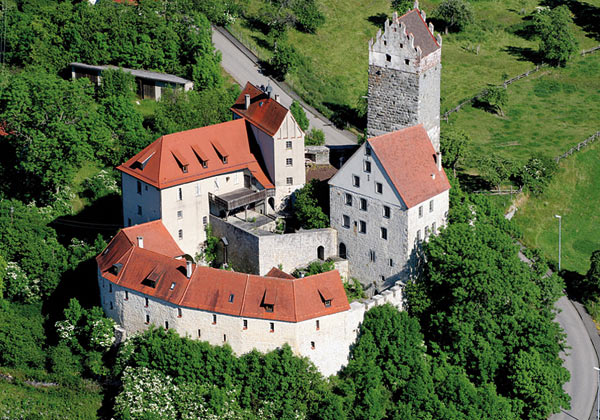

Location: Dischingen, Baden-Württemberg Map
Constructed: 1099
Open: 10am- 6pm Tue- Sun
Guided tours: 11am, 2pm, 3pm, 4pm
Closed: Mondays
Katzenstein Castle is located in Dischingen, Baden-Württemberg region in Germany. Katzenstein Castle was constructed in 1099 in the valley of the river Egua. The fortress occupied a strategic location over old Roman road located below. Katzenstein Castle was badly damaged toward the end of the Thirty Years' War in 1648 then French troops captured and burned Katzenstein Castle to the ground. In 1669 Katzenstein Castle was reconstructed with massive improvements. In 1810 abandoned ruins of the military fortifications were nationalized by the state of Württemberg. One of the most interesting sites in the Katzenstein Castle is a Saint Laurentius chapel. In 1970's it underwent a massive reconstruction revealing medieval frescoes paintings that date back to 1250- 80. Currently Katzenstein Castle is privately owned and it is open to the public. The grounds of Katzenstein Citadel contains a restaurant and several hotel rooms.
Early period
The castle was first mentioned in documents
dating back to 1099. The document confirms the transfer of the
church in Heilbronn to the control of the Amorbach monastery by
Bishop Emekhard von Würzburg, and Odalrich de Katzenstein is named
as a witness. However, based on the background of other witnesses
mentioned in this document, it can be assumed that the knight in
question does not belong to this fortress, but to the Katzenstein
castle built in the Franconian city of Langenburg (not preserved to
this day).
More reliable documents confirming the existence
of the castle date back to the 12th century. The noble family that
can be confidently said to be the owners of Katzenstein is mentioned
in 1153. The owner is also named - Rudegerus de Katzenstein. This
nobleman was the ministerial of the counts of Dillingen. The last
known member of this family is considered to be Konrad von
Katzenstein, who is mentioned in documents from 1288 as a resident
of Dillingen. The family ended with him.
Since 1262, the
noble family von Hürnheim lived in Katzenstein Castle. They turned
the fortress into their main residence, leaving their former family
castle Rauhaus. And soon the representatives of the family added the
prefix von Katzenstein to the family name.
In 1354, Hermann
von Hürnheim-Katzenstein sold the castle to the Counts of Oettingen.
In turn, they mortgaged the complex to the Counts von Helfenstein. A
representative of this family, Berthold von Westerstetten, married a
girl from the von Hürnheim-Katzenstein family in 1382. Thus, the
residence found a new owner and was included in the County of
Oettingen.
Renaissance
In 1572, the von
Katzenstein-Westerstetten family died out. The owner of the castle
became the overlord of the family, the Count of Oettingen.
In
1648, during the Thirty Years' War, the French army approached the
castle. Katzenstein was burned and destroyed during the siege. In
1669, Count Notger Wilhelm von Oettingen-Baldern repaired the
castle. Soon Katzenstein became one of the main residences of the
counts.
18th–19th centuries
In 1798, the last
representative of the Counts of Oettingen-Baldern died. He left no
legitimate male descendants. As a result, the castle passed to the
princely line of the von Oettingen-Wallerstein family.
The
residence was included in the Württemberg district of Neresheim in
1810. During the 19th century, the complex underwent a comprehensive
restoration and reconstruction.
20th century
Since 1939,
the castle has been open to the public. In 1997, Katzenstein was
included in the popular tourist route "Staufen Route". To date, the
residence remains privately owned.
Since October 2007,
Katzenstein Castle has been one of 26 information points in the
UNESCO Geopark Swabian Alb.
The castle is located on top of a high rocky hill. This hill is part
of the Risalb spur, the easternmost part of the Swabian Alb massif. The
castle dominates the Katzensteiner Bach valley, which is part of the
larger Egau Valley. The old Roman road Faimingen - Oberdorf (also called
Frankenstrasse) was located nearby.
The castle is surrounded by a
ring wall. Inside there is a small courtyard. In the southern part is
the main tower - bergfried. Its upper part is decorated with facades in
the style of stepped gable. The four-story building of the count's
residence is located in the eastern part of the complex. The last
serious changes in the external appearance of the castle took place in
the 17th century. Since then, the complex has only been restored and
repaired, but not rebuilt. On the eastern side in former times there was
a forburg, protecting the approach to the main gate leading into the
castle. The entrance to the complex is still located in the eastern
part.
A separate striking attraction is the castle chapel
dedicated to St. Lawrence. It was built around 1000 and decorated with
unique frescoes of the transitional period from the late Romanesque
style to early Gothic.
The castle is open to visitors. In the summer, a cafe operates inside. Some of the premises are adapted for museum exhibitions.